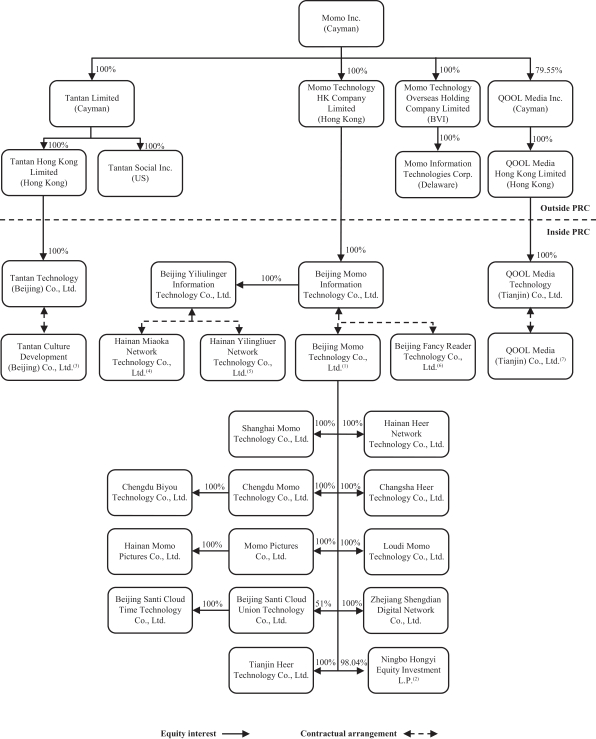UNITED STATES
SECURITIES AND EXCHANGE COMMISSION
Washington, D.C. 20549
Form 20-F
(Mark One)
| ☐ |
REGISTRATION STATEMENT PURSUANT TO SECTION 12(b) OR 12(g) OF THE SECURITIES EXCHANGE ACT OF 1934
|
or
| ☒ |
ANNUAL REPORT PURSUANT TO SECTION 13 OR 15(d) OF THE SECURITIES EXCHANGE ACT OF 1934
|
For the fiscal year ended December 31, 2018.
or
| ☐ |
TRANSITION REPORT PURSUANT TO SECTION 13 OR 15(d) OF THE SECURITIES EXCHANGE ACT OF 1934
|
For the transition period
from to
or
| ☐ |
SHELL COMPANY REPORT PURSUANT TO SECTION 13 OR 15(d) OF THE SECURITIES EXCHANGE ACT OF 1934
|
Date of event requiring this shell company report
For the transition period from
to
Commission file number: 001-36765
Momo Inc.
(Exact name of
Registrant as specified in its charter)
N/A
(Translation of Registrant’s name into English)
Cayman Islands
(Jurisdiction of incorporation or organization)
20th Floor, Block B
Tower 2, Wangjing SOHO
No.1 Futongdong Street
Chaoyang District, Beijing 100102
People’s Republic of China
(Address of principal executive offices)
Jonathan Xiaosong Zhang, Chief Financial Officer
Telephone: +86-10-5731-0567
Email: ir@immomo.com
20th Floor, Block B
Tower 2, Wangjing SOHO
No.1 Futongdong Street
Chaoyang District, Beijing 100102
People’s Republic of China
(Name, Telephone, Email and/or Facsimile number and Address of Company Contact Person)
Securities registered or to be registered pursuant to
Section 12(b) of the Act:
|
|
|
| Title of Each Class |
|
Name of Each Exchange on Which
Registered |
| American depositary shares (each American depositary share representing two Class A ordinary share, par value US$0.0001 per share) |
|
The NASDAQ Stock Market LLC
(The NASDAQ Global Select Market) |
|
|
| Class A ordinary shares, par value US$0.0001 per share* |
|
The NASDAQ Stock Market LLC
(The NASDAQ Global Select Market) |
| * |
Not for trading, but only in connection with the listing on The NASDAQ Global Select Market of American
depositary shares. |
Securities registered or to be registered pursuant to Section 12(g) of the Act:
None
(Title of Class)
Securities for which there is a reporting obligation pursuant to Section 15(d) of the Act:
None
(Title of Class)
Indicate the number of outstanding shares of each of the Issuer’s classes of capital or common stock as of the close of the period covered by the annual
report. 333,512,014 Class A ordinary shares and 80,364,466 Class B ordinary shares, par value US$0.0001 per share, as of December 31, 2018.
Indicate by check mark if the registrant is a well-known seasoned issuer, as defined in Rule 405 of the Securities
Act. Yes ☒ No ☐
If this report is an annual or transition report,
indicate by check mark if the registrant is not required to file reports pursuant to Section 13 or 15(d) of the Securities Exchange Act of 1934. Yes ☐ No ☒
Indicate by check mark whether the registrant (1) has filed all reports required to be filed by Section 13 or 15(d) of the Securities Exchange Act
of 1934 during the preceding 12 months (or for such shorter period that the registrant was required to file such reports), and (2) has been subject to such filing requirements for the past 90
days. Yes ☒ No ☐
Indicate by check mark whether the registrant has
submitted electronically every Interactive Data File required to be submitted pursuant to Rule 405 of Regulation S-T (§232.405 of this chapter) during the preceding 12 months (or for such shorter period
that the registrant was required to submit such files). Yes ☒ No ☐
Indicate by check mark whether the registrant is a large accelerated filer, an accelerated filer, a non-accelerated
filer or an emerging growth company. See definition of “large accelerated filer,” “accelerated filer,” and “emerging growth company” in Rule 12b-2 of the Exchange Act. (Check
one):
|
|
|
|
|
|
|
| Large accelerated filer |
|
☒ |
|
Accelerated filer |
|
☐ |
|
|
|
|
| Non-accelerated filer |
|
☐ |
|
Emerging growth company |
|
☐ |
If a an emerging growth company that prepares its financial statements in accordance with U.S. GAAP, indicate by check mark if
the registrant has elected not to use the extended transition period for complying with any new or revised financial accounting standards† provided pursuant to Section 13(a) of the Exchange Act. ☐
| † |
The term “new or revised financial accounting standard” refers to any update issued by the Financial
Accounting Standards Board to its Accounting Standards Codification after April 5, 2012. |
Indicate by check mark which basis of
accounting the registrant has used to prepare the financial statements included in this filing:
|
|
|
|
|
| U.S. GAAP ☒ |
|
International Financial Reporting Standards as issued by the International Accounting Standards Board ☐ |
|
Other ☐ |
If “Other” has been checked in response to the previous question, indicate by check mark which financial statement
item the registrant has elected to follow. Item 17 ☐ Item 18 ☐
If this is an annual report, indicate by check mark whether the registrant is a shell company (as defined in
Rule 12b-2 of the Exchange Act). Yes ☐ No ☒
(APPLICABLE ONLY TO ISSUERS INVOLVED IN BANKRUPTCY PROCEEDINGS DURING THE PAST FIVE YEARS)
Indicate by check mark whether the registrant has filed all documents and reports required to be filed by Sections 12, 13 or 15(d) of the Securities
Exchange Act of 1934 subsequent to the distribution of securities under a plan confirmed by a court. Yes ☐ No ☐
